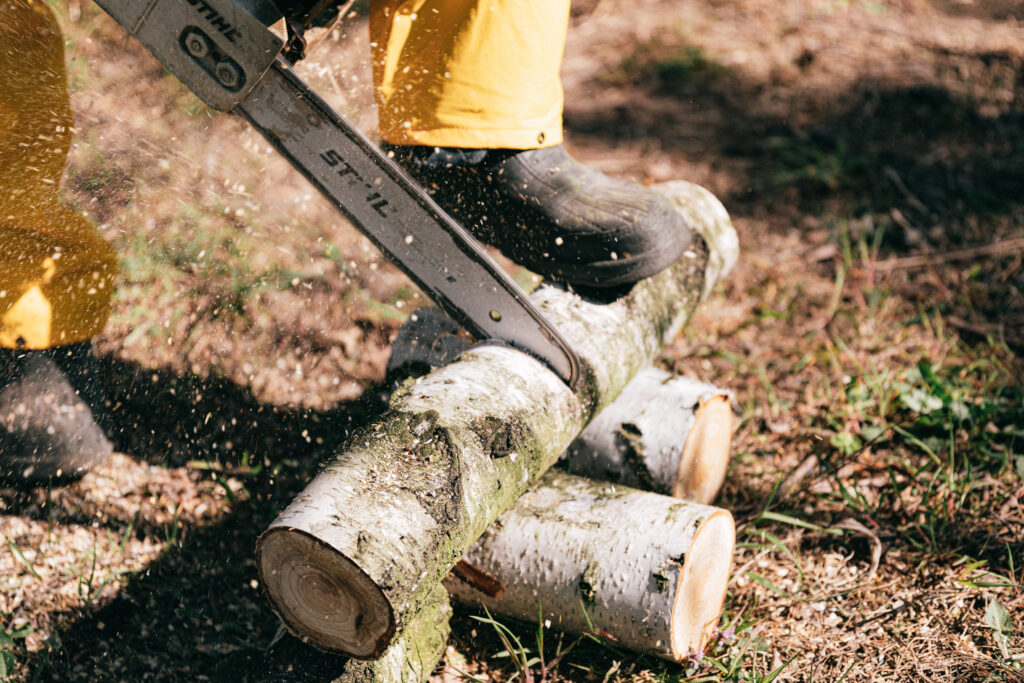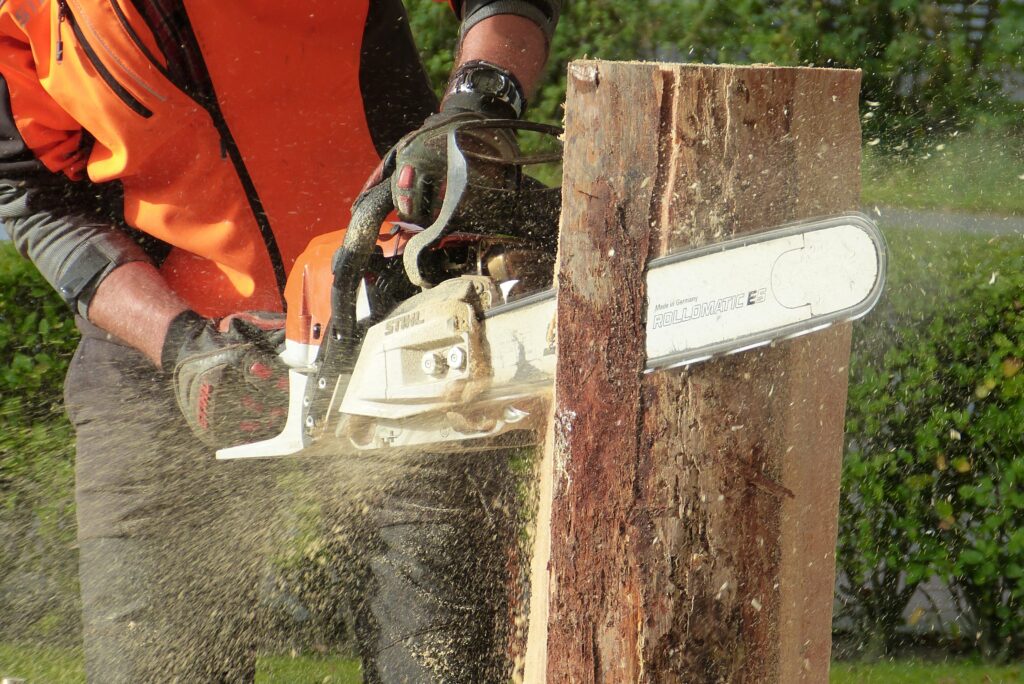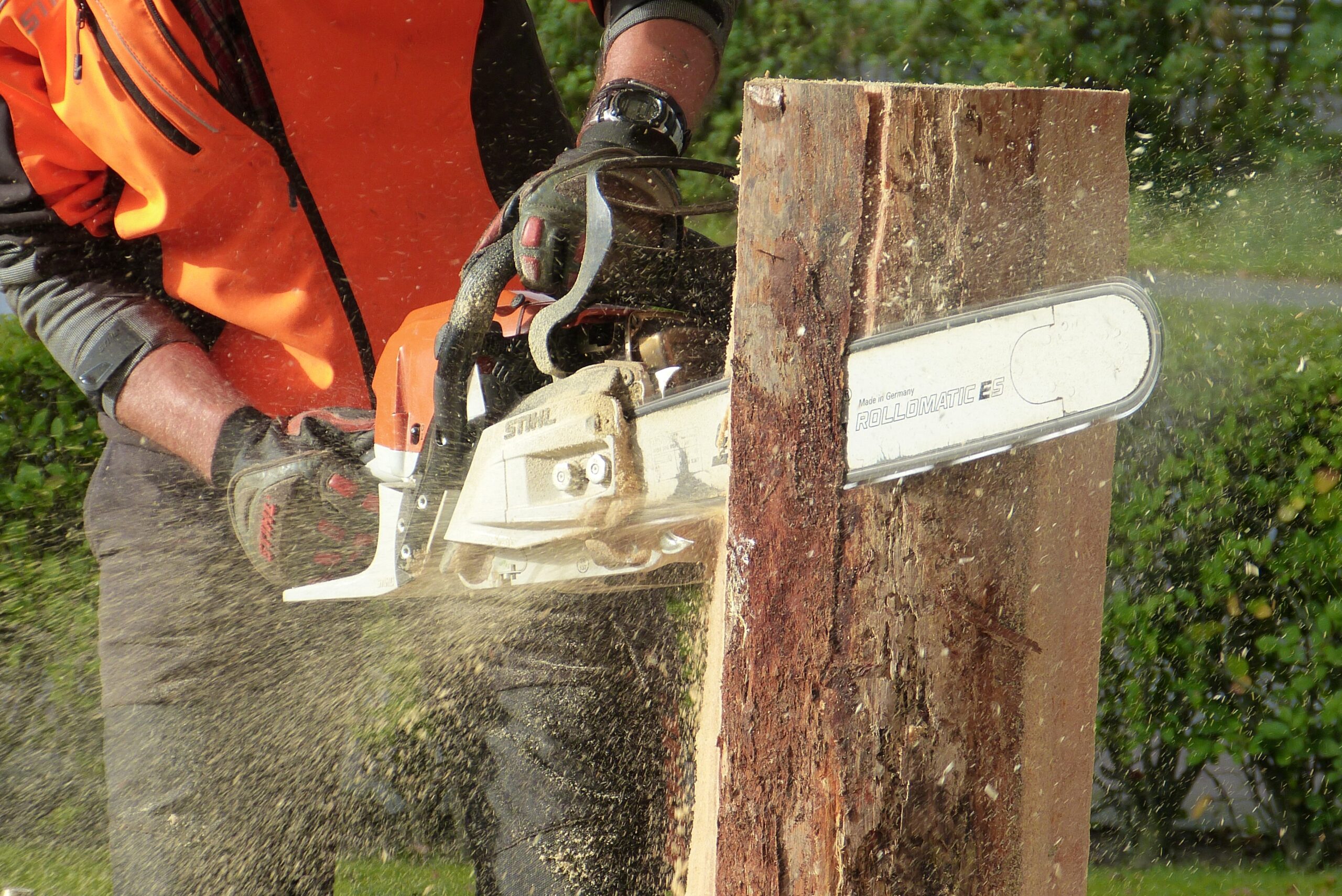Imagine standing in your backyard, looking at a majestic tree that needs to be cut down. You have a chainsaw in your hand but no idea how to use it for tree cutting. Don’t worry, we’ve got you covered! In this article, we will guide you on the step-by-step process of using a chainsaw for tree cutting, ensuring that you complete the task safely and efficiently. From preparing the area to mastering the cutting techniques, you’ll become a pro in no time. Let’s get started on turning that daunting task into a breeze!
Choosing the Right Chainsaw
When it comes to choosing the right chainsaw for your tree cutting needs, there are a few factors to consider. First and foremost, you need to take into account the size of the tree you will be working with. If you are planning to cut down small to medium-sized trees or trim branches, a smaller chainsaw with a shorter bar length will suffice. On the other hand, if you are tackling larger trees, you will need a chainsaw with a longer bar length to effectively handle the task.
Another important consideration is the power source options available for chainsaws. There are three main types: gas-powered, electric, and battery-powered chainsaws. Gas-powered chainsaws are known for their power and mobility, making them ideal for heavy-duty tree cutting. Electric chainsaws are more lightweight and easier to maintain, but they are generally not as powerful as gas-powered ones. Battery-powered chainsaws offer the advantage of being cordless and environmentally friendly, but they may have limitations in terms of power and runtime.
Lastly, it is crucial to look for chainsaws with safety features. Some essential safety features to consider include a chain brake, which immediately stops the chain in case of kickback, and a low kickback chain, which reduces the risk of the chain snagging or jumping off the guide bar. Additionally, chainsaws with anti-vibration handles can help minimize fatigue during prolonged use.
Preparing for Tree Cutting
Before starting any tree cutting job, it is essential to properly prepare yourself and your equipment. One of the first steps is to inspect the chainsaw thoroughly. Check for any loose or damaged parts and ensure that the chain tension is properly adjusted. It is also important to make sure that the chain is adequately lubricated with chain oil.
Equally important is wearing appropriate safety gear. This includes a hard hat to protect your head from falling debris, safety goggles or a face shield to shield your eyes from flying wood chips, ear protection to reduce noise levels, and sturdy gloves to protect your hands from cuts and vibrations.
Furthermore, it is crucial to clear the work area before starting the tree cutting process. Remove any obstacles, such as rocks or sticks, that could potentially interfere with your movements. Also, be aware of any overhead power lines or nearby structures that could be damaged during tree removal. Keeping the work area clear ensures your safety and helps prevent accidents.

Starting the Chainsaw
Before starting the chainsaw, there are a few key steps to follow to ensure proper functioning and safety. First, check the fuel and oil levels. Make sure there is enough fuel in the gas tank and that the chain oil reservoir is adequately filled. Running out of fuel or chain oil during operation can damage the chainsaw and compromise safety.
Next, engage the chain brake. The chain brake is a safety feature that, when engaged, prevents the chain from rotating. This is important when starting the chainsaw, as it ensures that the chain will not accidentally start spinning, reducing the risk of injury.
After engaging the chain brake, prime the engine. This involves pressing the primer bulb a few times to deliver fuel to the carburetor. Priming the engine helps facilitate the starting process, particularly if the chainsaw has been idle for a while. Once the engine is primed, you are ready to start the chainsaw.
Basic Chainsaw Techniques
Effective and safe chainsaw operation relies on mastering basic techniques. Proper positioning and grip are crucial for maintaining control and balance while using the chainsaw. Stand with your feet shoulder-width apart and hold the chainsaw with both hands, one hand on the rear handle and the other on the front handle. This grip allows for optimal control and maneuverability.
When starting the cutting technique, position the chainsaw so that the bottom of the guide bar contacts the wood first. Apply gentle pressure to begin the cut and gradually increase the pressure as the chainsaw begins to bite into the wood. Avoid forcing the saw or applying too much pressure, as this can cause kickback or damage the chainsaw.
Maintaining balance and stability while operating the chainsaw is crucial for safety. Avoid overreaching or working from unstable positions, as this can lead to loss of control. Always keep your body to the side of the chainsaw and stay alert to any signs of fatigue or discomfort that may compromise your stability.

Cutting Techniques for Different Trees
Depending on the type and size of trees you are cutting, different cutting techniques may be required. For cutting small limbs and branches, a technique known as “undercutting” is often used. With an undercut, you make an initial horizontal cut on the underside of the limb to prevent the bark from tearing or splintering. After the undercut, make a second cut from the top, just outside the first cut, to remove the limb cleanly.
When cutting down small trees, a technique called “bucking” is commonly used. Bucking involves cutting the trunk of the tree into logs of manageable size. Start by making a horizontal cut, known as a “felling cut,” on the side of the tree facing the direction you want it to fall. Then, make a second cut, known as a “back cut,” on the opposite side of the tree, slightly above the felling cut. As the tree begins to fall, move to a safe location.
For felling larger trees, it is recommended to hire a professional tree removal service. Felling large trees requires advanced techniques, such as directional notching, that are best left to experienced professionals. Attempting to fell large trees without the necessary skills and equipment can be extremely dangerous.
Dealing with Dangerous Situations
When using a chainsaw, it is essential to be aware of potential hazards and to know how to handle dangerous situations. One critical skill is identifying potential hazards in your work area. Look for factors such as uneven terrain, dead or rotten limbs, and branches under tension. Identifying and addressing these hazards before starting tree cutting can prevent accidents and injuries.
In case of an emergency, it is crucial to know how to perform an emergency stop. This involves releasing the throttle trigger, engaging the chain brake, and turning off the chainsaw. Practicing this technique can help you react promptly and effectively in a dangerous situation.
One of the most common dangers associated with chainsaw use is kickback. Kickback occurs when the moving chain at the tip of the guide bar suddenly stops or gets pinched, causing the saw to jerk back towards the operator. To handle kickback, always maintain a firm grip on the chainsaw and position yourself to the side of the saw to minimize the risk of injury.

Maintaining and Sharpening the Chainsaw
Regular maintenance and proper chain sharpening are essential for ensuring the longevity and effectiveness of your chainsaw. Cleaning the chain and bar after each use helps remove debris and prevent damage. Use a brush or a specialized tool to remove sawdust, wood chips, and other debris from the chain and bar. Additionally, inspect the chain regularly for signs of wear or damage, and replace it if necessary.
Sharpening the chain is crucial for maintaining cutting performance. Dull chains can cause the saw to work harder and increase the risk of kickback. To sharpen the chain, use a round file and a file guide to maintain consistent angles and ensure a sharp cutting edge. Regularly inspecting and replacing worn out chains helps optimize cutting efficiency and reduces the strain on the chainsaw.
Safety Tips and Precautions
When operating a chainsaw, it is important to prioritize safety at all times. To maintain a safe distance from the cutting area, stand at least 10 feet away from the falling zone when cutting down trees or limbs. Avoid cutting in risky conditions, such as during strong winds or icy conditions, as these factors can make tree cutting more dangerous.
Always be mindful of bystanders and communicate with them to ensure their safety. Alert anyone in the vicinity of your planned cutting area, and make sure they are a safe distance away. Additionally, never work alone when using a chainsaw, as having a second person present can be crucial in case of emergencies.
Caring for the Environment
Tree cutting inevitably produces debris and impacts the surrounding environment. To minimize the environmental impact, properly dispose of the tree debris. Consider composting or chipping the smaller branches and limbs. Larger logs can be used for firewood or repurposed for other projects. Proper and responsible disposal of tree debris reduces waste and helps support a healthier environment.
When cutting trees, be mindful of surrounding vegetation and aim to minimize damage. Avoid injuring nearby trees or plants while working on a specific tree. Taking care not to cause unnecessary harm to surrounding vegetation helps maintain the balance and health of the ecosystem.
For more significant tree removal tasks or situations where safety is a concern, it is advisable to consider hiring professional tree removal services. Professional arborists have the expertise, experience, and specialized equipment to safely and efficiently remove trees. They can also provide valuable advice on tree care and help ensure the well-being of your property and the environment.
Troubleshooting Chainsaw Issues
When using a chainsaw, you may encounter certain issues that affect its performance. One common problem is difficulty starting the chainsaw. This can be caused by various factors, including a flooded engine, a clogged fuel filter, or a faulty ignition system. Following the manufacturer’s instructions for starting the chainsaw and periodically maintaining the fuel system can help alleviate starting issues.
Another issue you may face is a lack of cutting power. This can be caused by a dull chain, insufficient chain oil, or a worn-out guide bar. Regularly inspecting and sharpening the chain, ensuring proper chain oil lubrication, and replacing worn-out guide bars can help restore the cutting power of your chainsaw.
Excessive chain oil consumption is another issue that may arise. If your chainsaw seems to be using an excessive amount of chain oil, it may be due to a clogged oiler hole or a malfunctioning oil pump. Cleaning the oiler hole and checking the oil pump for proper functioning can help resolve this problem and ensure adequate lubrication for the chain.
In conclusion, using a chainsaw for tree cutting requires careful consideration of various factors, including choosing the right chainsaw, preparing adequately, mastering basic techniques, and prioritizing safety. By following proper procedures, maintaining the chainsaw, and being mindful of the environment, you can safely and effectively complete tree cutting tasks.



